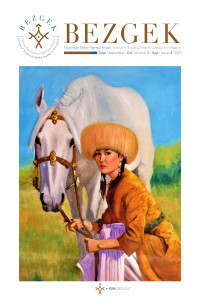İyi ve Kötü Prens Öyküsündeki Kültürel Değerler
ÖZ Kültür, toplumların kendilerine özgü olan ve gelecek nesillere aktardıkları maddi veya manevi her şeydir. Kültürel değer ise bir milletin geçmiş zamanlardan bu zamanlara kadar taşıdığı, koruyarak önemsediği ve yaşattığı değerler bütünüdür. Türk dili tarihinde Eski Türkçe dönemi, MS V. yüzyıl ile XI. yüzyıl arasını kapsamaktadır. Eski Türkçenin Göktürkçeden (V.-VIII. yy.) sonra gelen ikinci evresini Eski Uygur Türkçesi dönemi (V.-XV. yy.) oluşturmaktadır. Tarih boyunca farklı din ve inanışlara (Maniheizm, Budizm, Hristiyanlık ve İslamiyet) mensup olan Uygurlar, yerleşik hayata geçmelerinin de etkisiyle kültürel yönden oldukça çeşitlilik taşımaktadır. Nitel araştırma desenlerinden doküman incelemesi yönteminin kullanıldığı bu çalışmada, Eski Uygur Dönemi’ne ait Budist çatik adı verilen anlatılardan İyi ve Kötü Prens Öyküsü’nde yer alan kültürel değerler incelenmiş ve tespit edilmiştir. İyi ve Kötü Prens Öyküsü, günümüzde Bibliotheque Nationale’de Pelliot Chinois adıyla Paris’te muhafaza edilmektedir. Öyküde yer alan kültürel değerleri tespit etmek için Milli Eğitim Bakanlığı tarafından hazırlanan öğretim programlarında yer alan kök değerler esas alınmıştır. Bu değerler; adalet, dostluk, dürüstlük, öz denetim, sabır, saygı, sevgi, sorumluluk, vatanseverlik, yardımseverlik olarak sıralanabilir. Verilen değerler doğrultusunda İyi ve Kötü Prens Öyküsü’nün, kültürel değerleri barındırma yönünden zengin bir eser olduğu sonucuna varılabilir. Anahtar Kelimeler: İyi ve Kötü Prens Öyküsü, kültürel değer, Budist Uygur eserleri. ABSTRACT Culture is everything material or spiritual that societies are unique to them and that they pass on to future generations. Cultural value, on the other hand, is the set of values that a nation carries, protects, cares about and keeps alive from past times to these times. The Old Turkish period in the history of the Turkish language covers the period from the V century AD to the XI century. The second phase of Old Turkish, which comes after Göktürk (V.-VIII. century.), is the Old Uyghur Turkish period (V.-XV. century). Uyghurs, who have belonged to different religions and beliefs (Manichaeism, Buddhism, Christianity and Islam) throughout history, are culturally very diverse with the effect of their settled life. In this study, where the document examination method from qualitative research designs was used, the cultural values in “İyi ve Kötü Prens Öyküsü”, one of the narratives called Buddhist çatik belonging to the Old Uyghur Period, were examined and identified. “İyi ve Kötü Prens Öyküsü” is now preserved in Paris as Pelliot Chinois in the Bibliotheque Nationale. In order to determine the cultural values in the story, the root values in the curriculum prepared by the Ministry of National Education were taken as basis. These values are; justice, friendship, honesty, self-control, patience, respect, love, responsibility, patriotism, benevolence. In line with the values given, it can be concluded that “İyi ve Kötü Prens Öyküsü” is a work rich in cultural values. Keywords: İyi ve Kötü Prens Öyküsü, cultural value, Buddhist Uyghur works.
Anahtar Kelimeler:
İyi ve Kötü Prens Öyküsü, kültürel değer, Budist Uygur eserleri.
Cultural Values in the Tale of the Good and the Evil Prince
Culture is defined as anything material or spiritual that is unique to societies and that they pass on to future generations. Cultural value, on the other hand, is the sum of the values that a nation carries from the past to the present, cares about, and keeps alive. In the history of the Turkish language, the Old Turkish Period is between the fifth century and the eleventh century AD. Old Uyghur Turkish Period (5th and 15th century) constitutes the second phase of Old Turkish after Gokturk (5th and 8th centuries). Uyghurs, who belonged to different religions and beliefs (Manichaeism, Buddhism, Christianity, and Islam) throughout history, developed themselves culturally with the influence of their settled life. This study, in which document analysis is used as a method, is qualitative research. The study identifies and discusses the cultural values in the Tale of the Good and the Evil Prince, one of the narratives of the Old Uyghur Period called Buddhist chatik. To determine the cultural values in the tale, which is currently in the Bibliothéque Nationale in Paris with the number Pelliot Chinois 3509 and in the British Museum with the number Or. 8212 (118), the root values in the curriculum prepared by the Ministry of National Education will serve as a basis. These values can be listed as justice, friendship, honesty, self-control, patience, respect, love, responsibility, patriotism, and benevolence. In line with the findings, it is possible to say that The Tale of the Good and the Evil Prince is a rich work in terms of containing cultural values.
___
- Aksan, D. (2009). Türkçenin gücü. Bilgi Yayınevi.
- Aksan, D. (2020). Türkçeye yansıyan Türk kültürü. Bilgi Yayınevi.
- Buran, A. ve Alkaya, E. (2013). Çağdaş Türk lehçeleri. Akçağ Yayınları.
- Caferoğlu, A. (2011). Eski Uygur Türkçesi sözlüğü. Türk Dil Kurumu Yayınları.
- Ercilasun, A.B. (2013). Türk dili tarihi. Akçağ Yayınları.
- Hamilton, J. R. (1998). Buddhacılığa ilişkin Uygurca El Yazması İyi ve Kötü Prens öyküsü. Çev. Vedat KÖKEN. Türk Dil Kurumu Yayınları.
- Kaplan, M. (2021). Kültür ve dil. Dergâh Yayınları.
- Yıldırım, M. (2017). Pakize Özcan’ın eserlerinin değerler eğitimi açısından incelenmesi [Yayımlanmamış Yüksek Lisans Tezi]. Fırat Üniversitesi.
- Yıldırım, A. ve Şimşek, H. (2013). Sosyal bilimlerde nitel araştırma yöntemleri. Ankara: Seçkin Yayıncılık.
- https://islamansiklopedisi.org.tr/uygurlar 01.05.2023 tarihinde erişilmiştir.
- http://mufredat.meb.gov.tr/ProgramDetay.aspx?PID=411 30.04.2023 tarihinde erişilmiştir. http://mufredat.meb.gov.tr/ProgramDetay.aspx?PID=345 30.04.2023 tarihinde erişilmiştir. https://tr.wikipedia.org/wiki/Budist_felsefe 02.05.2023 tarihinde erişilmiştir.
- Başlangıç: 2022
- Yayıncı: Uluslararası Türkçe Edebiyat Kültür Eğitim Derneği
Sayıdaki Diğer Makaleler
Türkçenin Yabancı Dil Olarak Öğretiminde Hazırlanmış Bilimsel Kitap ve Ders Kitapları
İyi ve Kötü Prens Öyküsündeki Kültürel Değerler
Doç. Dr. Zeki Gürel’in 67. Yaşı Dolayısıyla
Türkçenin Yabancı Dil Olarak Öğretiminde Hazırlanmış Yüksek Lisans ve Doktora Tezleri
Yabancı Dil Olarak Türkçe Öğreniminde E-Tandemlerin Öğrenmeye Etkisi
Türkçenin Yabancı Dil Olarak Öğretiminde Hazırlanmış Makale ve Bildiriler
